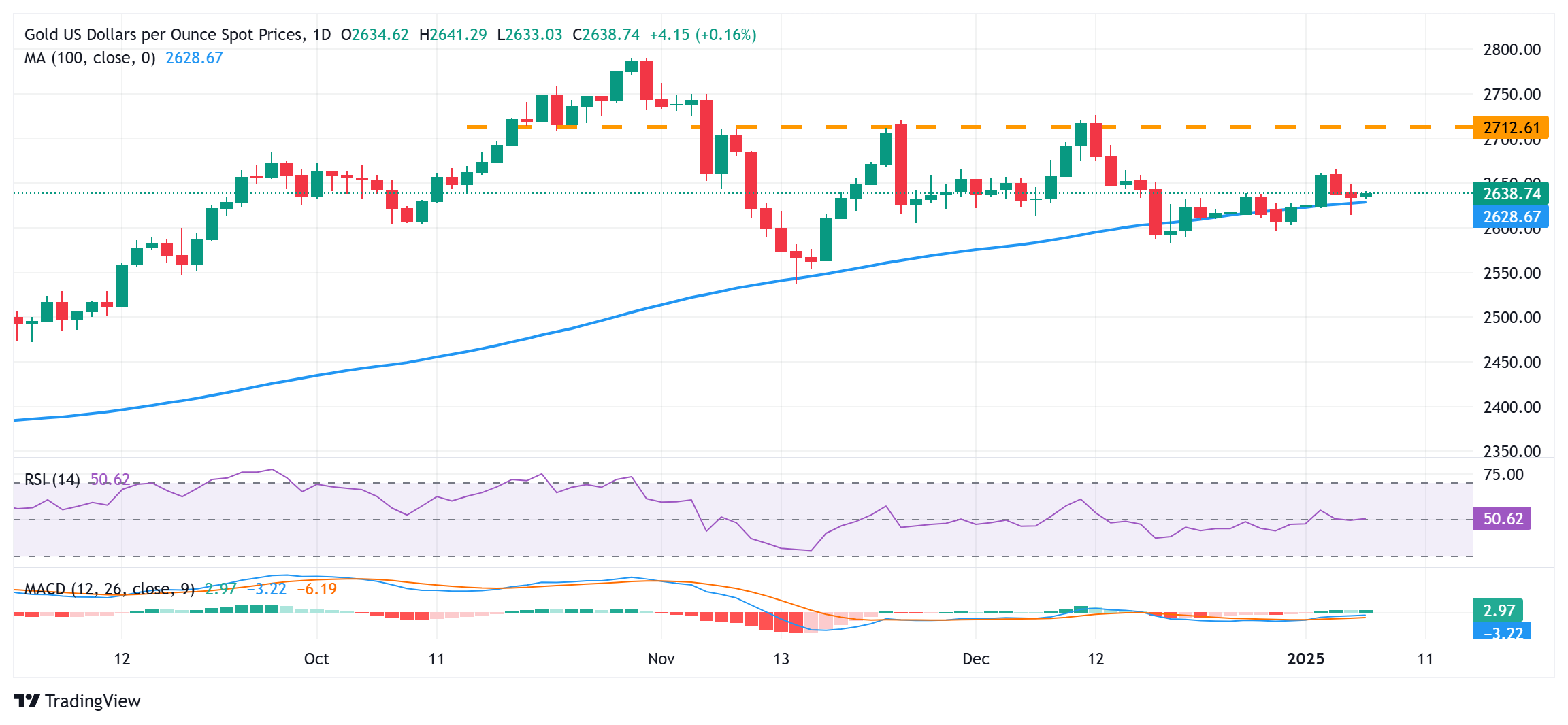Gold sticks to modest gains; lacks bullish conviction amid Fed’s hawkish shift

- Gold price attracts some haven flows amid worries about Trump’s tariff plans.
- The Fed’s hawkish shift and elevated US bond yields cap gains for the XAU/USD.
- Traders seem reluctant ahead of FOMC minutes and US NFP releases later this week.
Gold price (XAU/USD) builds on the overnight bounce from the $2,615-2,614 area and gains some positive traction during the Asian session on Tuesday, though it lacks follow-through. Expectations that US President-elect Donald Trump’s proposed tariffs and protectionist policies could reignite inflation seem to benefit the commodity’s status as a hedge against rising prices. Apart from this, geopolitical risks stemming from the protracted Russia-Ukraine war and tensions in the Middle East drive some haven flows towards the precious metal.
That said, the Federal Reserve’s (Fed) hawkish signal that it would slow the pace of rate cuts in 2025, which remains supportive of elevated US Treasury bond yields, acts as a headwind for the non-yielding Gold price. Apart from this, the emergence of some US Dollar (USD) dip-buying contributes to capping gains for the yellow metal. Traders also seem reluctant to place aggressive directional bets ahead of this week’s release of the FOMC meeting minutes and the crucial US Nonfarm Payrolls (NFP) report on Wednesday and Friday, respectively.
Gold price struggles to capitalize on modest uptick amid Fed’s hawkish stance, elevated US bond yields
- US President-elect Donald Trump’s proposed tariffs and protectionist policies are expected to stoke further inflation and disrupt global trade, offering support to the safe-haven Gold price.
- The Ukrainian military launched a new offensive in the Kursk region of western Russia on Sunday. Russia’s Defence Ministry said that Ukraine lost up to 340 soldiers in the Kursk region.
- As Israel’s relentless bombardment of Gaza continues, the Israeli military said on Sunday that it has been conducting operational raids in Syria amid accusations of cease-fire violations.
- The Federal Reserve’s projections in December implied a shift to a more cautious pace of rate cuts in 2025, with the majority of the policymakers expressing concern that inflation could reignite.
- San Francisco Fed President Mary Daly said on Saturday that despite significant progress in lowering price pressures over the past two years, inflation remains uncomfortably above the 2% target.
- Furthermore, Fed Governor Lisa Cook said on Monday that policymakers could be more cautious with further interest rate cuts, citing labor market resilience and still stickier inflation.
- The yield on the benchmark 10-year US government bond rose to an over eight-month high on Monday, assisting the US Dollar to attract some dip-buying on Tuesday and capping the XAU/USD.
- The market focus this week remains glued to the release of the FOMC meeting minutes and the closely-watched US Nonfarm Payrolls (NFP) report on Wednesday and Friday, respectively.
- In the meantime, Tuesday’s US economic docket – featuring the ISM Services PMI and JOLTS Job Openings data – could provide some impetus later during the North American session.
Gold price needs to clear the $2,655-2,657 horizontal barrier for bulls to seize near-term control
From a technical perspective, the overnight resilience above the 100-day Simple Moving Average (SMA) and the subsequent bounce warrants some caution for bearish traders. Moreover, oscillators on the daily chart have recovered from negative territory, which, in turn, supports prospects for some near-term upside. Any further move up, however, is likely to confront some resistance near the $2,655-2,657 horizontal zone ahead of the $2,665 area, or the multi-week high touched last Friday. The momentum could extend further towards an intermediate resistance near the $2,681-2,683 zone en route to the $2,700 mark. The latter should act as a pivotal point, which if cleared will set the stage for an extension of a two-week-old uptrend.
On the flip side, the 100-day SMA, currently pegged near the $2,626 area, followed by the overnight swing low, around the $2,615-2,614 region, and the $2,600 mark could offer some support to the Gold price. This is followed by the December swing low, around the $2,583 area, which if broken will be seen as a fresh trigger for bearish traders and pave the way for deeper losses.
